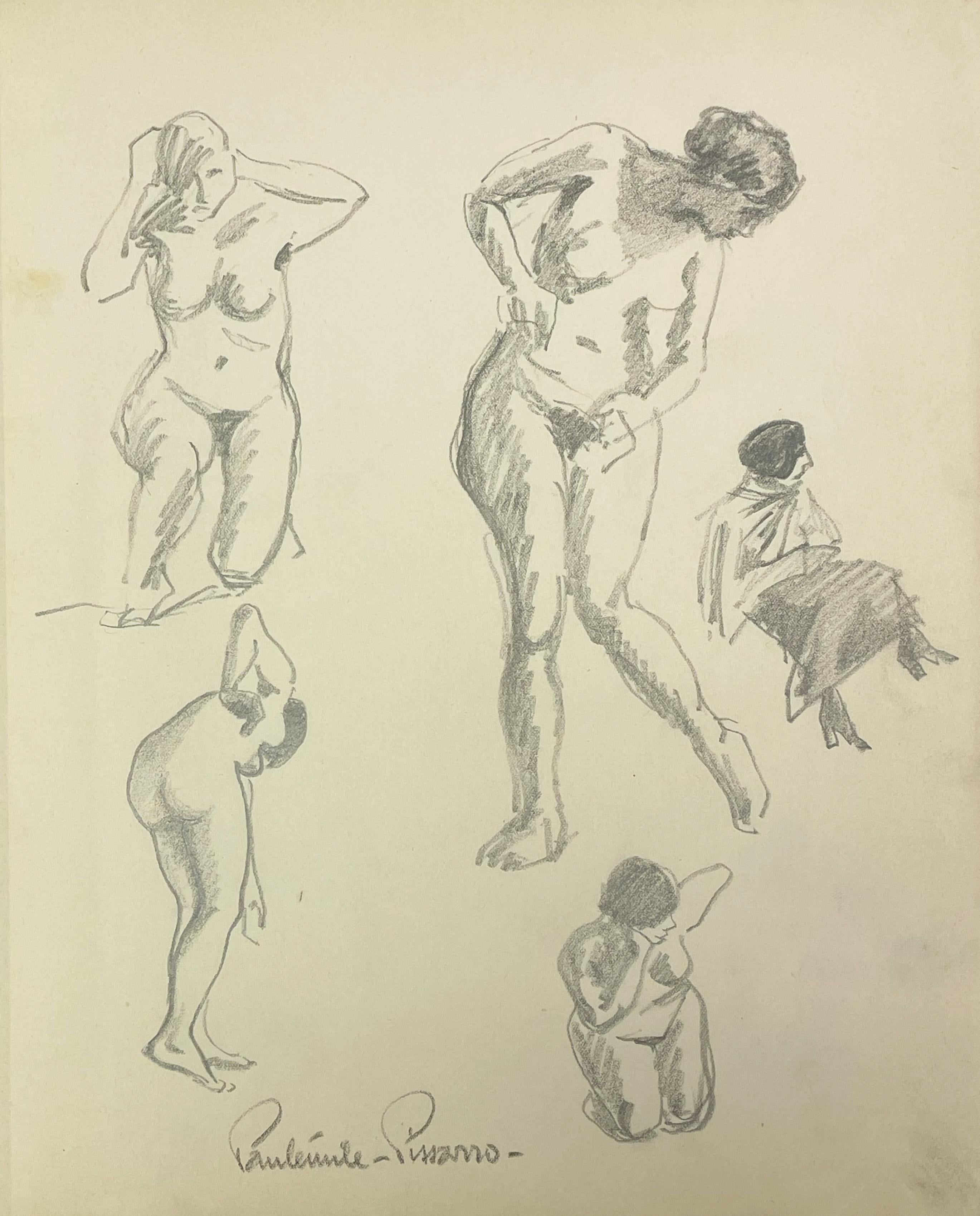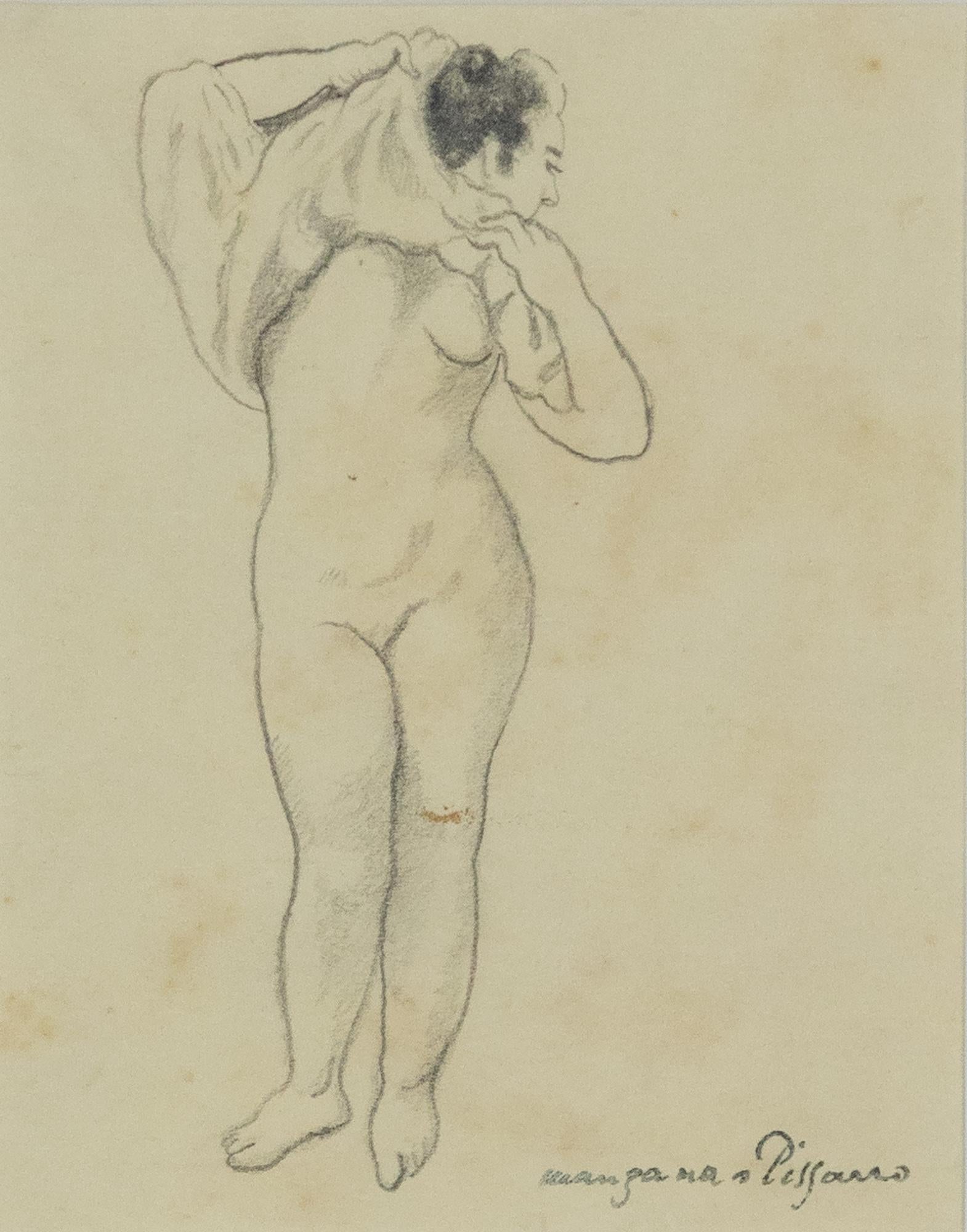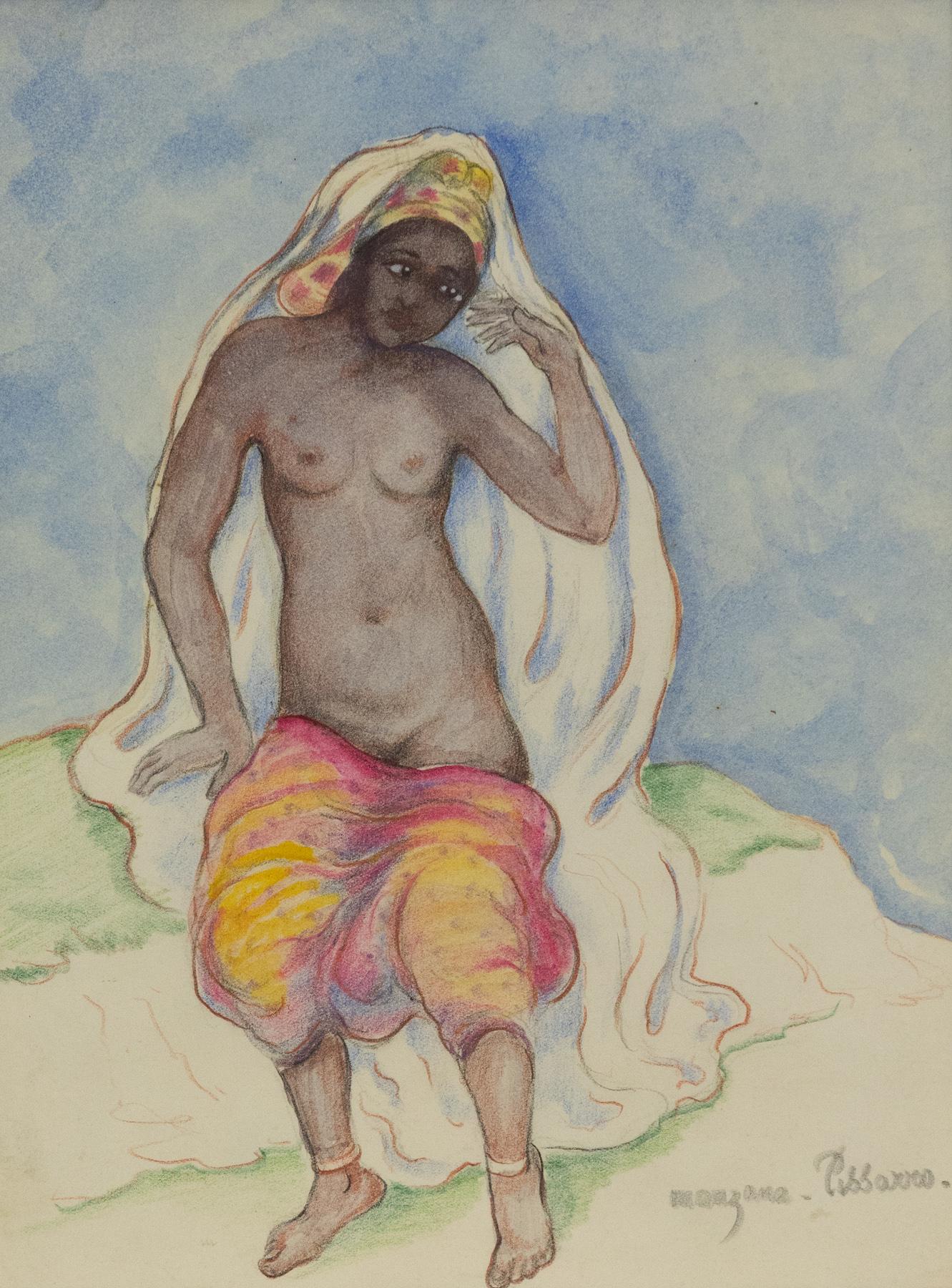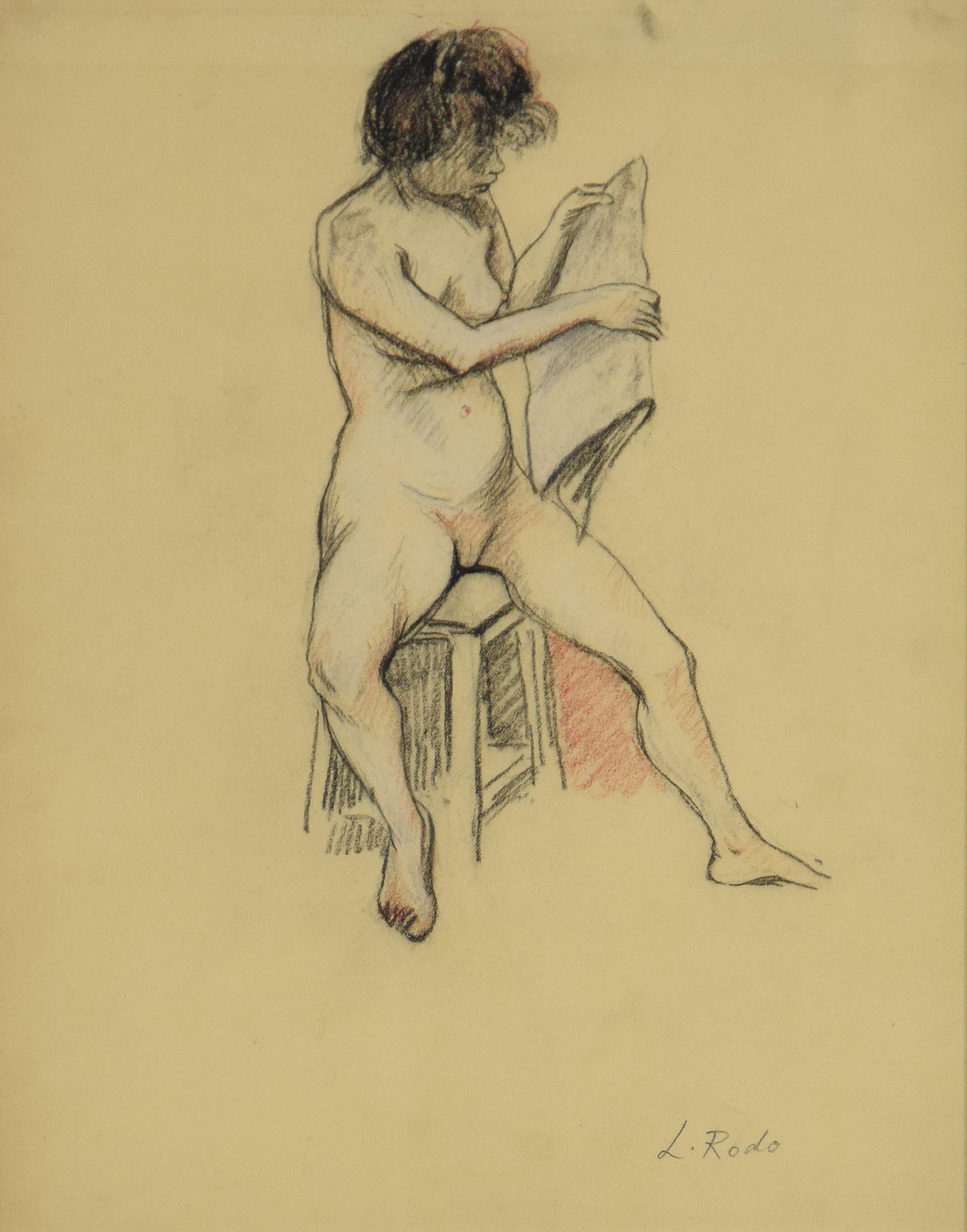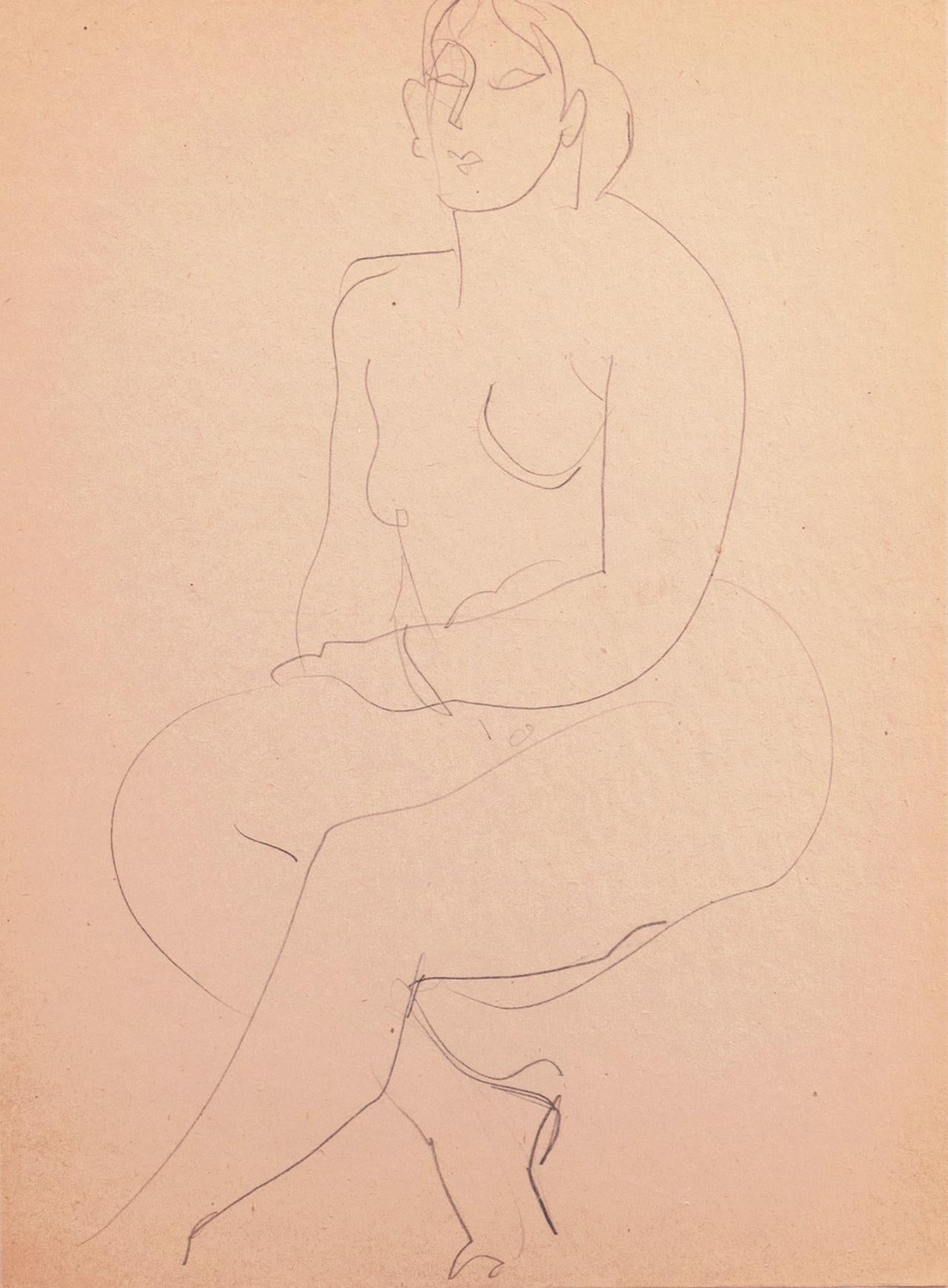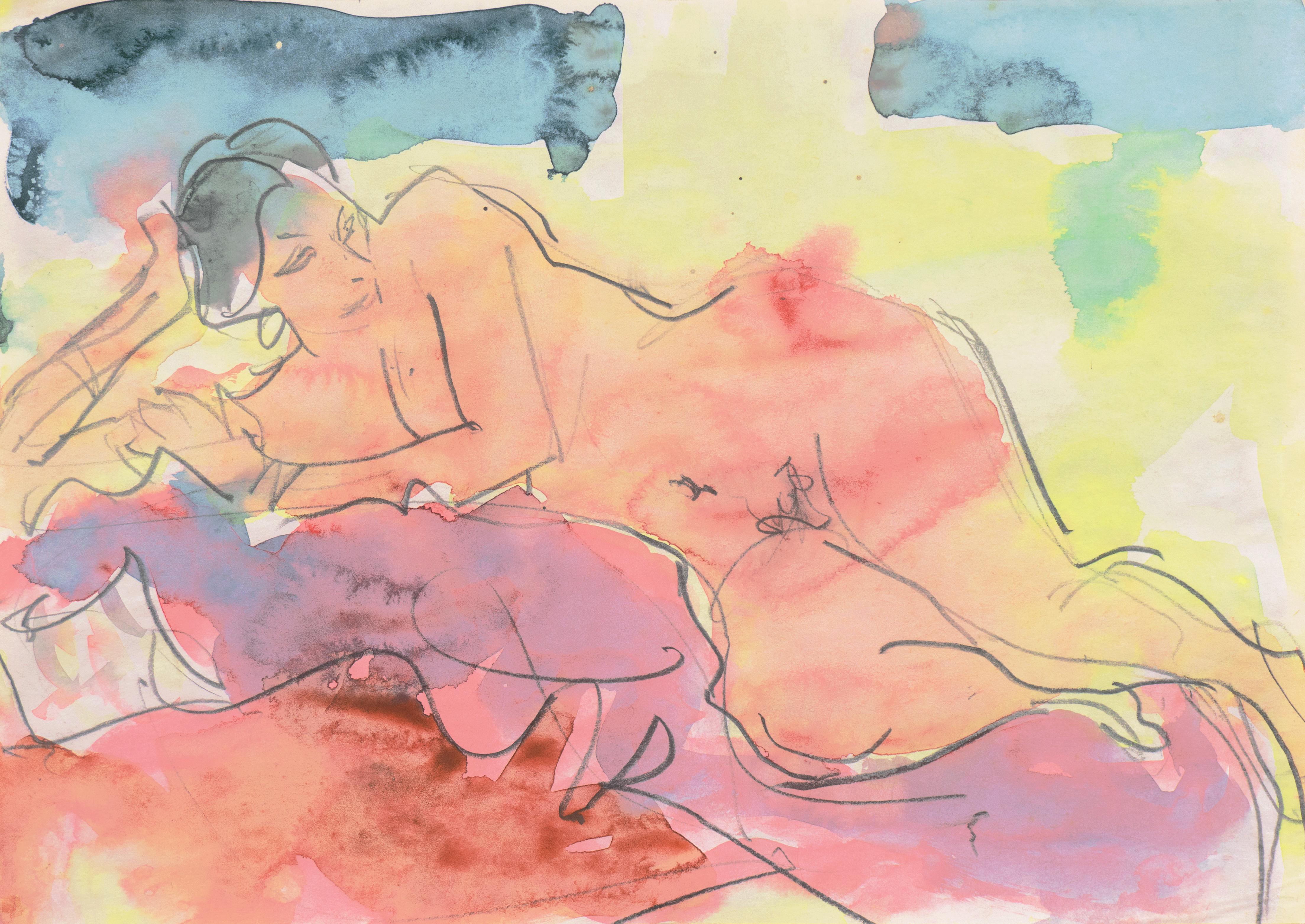Items Similar to Yvonne debout by Paulémile Pissarro - Nude drawing of the artist's wife
Want more images or videos?
Request additional images or videos from the seller
1 of 7
Paul Emile PissarroYvonne debout by Paulémile Pissarro - Nude drawing of the artist's wife
About the Item
THIS WORK IS SOLD UNFRAMED
Yvonne debout by Paulémile Pissarro (1884-1972)
Pencil on paper
30.5 x 26 cm (12 x 10 ¹/₄ inches)
Signed lower centre, Paulémile Pissarro and titled Yvonne lower right
Paulémile's wife, Yvonne, was the model for this drawing.
This work is accompanied by a certificate of authenticity from Lélia Pissarro.
Provenance
Estate of the artist
Artist biography
Paulémile Pissarro, Camille Pissarro’s youngest son, was born in Éragny in 1884 where he was brought up within the creatively fertile environment of his family home and, encouraged by his father, began drawing at an early age. Paulémile’s godfather was Claude Monet, who became his teacher and legal guardian after Camille’s death in 1903.
In 1905 Paulémile exhibited at the Salon des Indépendants for the first time. Although his father had supported Paulémile’s desire to be an artist, his mother was eager for him to learn a more practical trade. Therefore in 1908 he put aside his artistic pursuits to work as an automobile mechanic and test-driver, then later as a lace and textile designer, allowing him only a limited time to paint. Paulémile only fully dedicated himself to painting following a letter from his brother Lucien in London, who wrote to invite him to take part in an exhibition held in London. Subsequent to the successful sale of a number of watercolours he had sent over, the young artist became inspired to leave the textile factory and pursue a career in art.
By the 1920s Paulémile had become an established Post-Impressionist artist in his own right, spending the summer months escaping from Paris on painting trips with fellow artists Kees Van Dongen, Raoul Dufy, Maurice de Vlaminck and André Dunoyer de Segonzac. In 1922 Paulémile purchased a house in Lyons-la-Forêt, a small village within the region of his hometown of Éragny and Giverny, where he moved in with his first wife Berthe Bennaiche. During this time, he developed a form of Cubism inspired by Paul Cézanne whom he dearly admired, creating some wonderful paintings of the river Eure and its surrounding villages. There he formed a close friendship with his neighbour, the famous Art Deco designer Émile-Jacques Ruhlmann, who designed a stunning Art Deco studio for Paulémile adjacent to his house.
In 1930 he visited and fell in love with the Swiss Normandy area in the Calvados region, in particular the River Orne which runs through the valley adjacent to the villages of Clécy and St. Remy. The combination of rolling hills, bold meadows and the calm river weaving its way through the landscape offered Paulémile a new burst of inspiration. With his second wife Yvonne Beaupel, Paulémile eventually moved to Clécy in 1935, where he would remain for the rest of his life. Of their three children, both H. Claude and Yvon also became artists.
With his house backing on to the river Orne, Paulémile developed a new way of working using a boat as a floating studio, where he spent countless days painting the calm waters from between the riverbanks. Here the influence of his godfather Claude Monet became apparent, particularly in Paulémile’s depiction of water, which was revolutionised by the Impressionist icon. He also applied Monet’s lessons in horticulture to the creation of an abundant garden, offering him many more motifs for his new paintings. Alongside these river landscapes, he also painted the neighbouring hay fields, various snow scenes, some interiors and still lives. The most ambitious work in his oeuvre was a fresco painted on all four walls of his own dining room, depicting the adjacent river in which he includes family members, neighbours and friends.
In 1967 Paulémile had his first one-man show in the United States at Wally Findlay Galleries in New York. This led to widespread recognition and a degree of professional success that few Pissarro artists knew during their lifetime. Since his death in 1972, Paulémile remains one of the best known of Camille’s sons.
- Creator:Paul Emile Pissarro (1884-1972, French)
- Dimensions:Height: 12.01 in (30.5 cm)Width: 10.24 in (26 cm)
- Medium:
- Movement & Style:
- Period:
- Condition:
- Gallery Location:London, GB
- Reference Number:1stDibs: LU261213462752
About the Seller
5.0
Recognized Seller
These prestigious sellers are industry leaders and represent the highest echelon for item quality and design.
Platinum Seller
These expertly vetted sellers are 1stDibs' most experienced sellers and are rated highest by our customers.
Established in 1964
1stDibs seller since 2015
95 sales on 1stDibs
Typical response time: 4 hours
Associations
Society Of London Art Dealers
- ShippingRetrieving quote...Ships From: London, United Kingdom
- Return PolicyA return for this item may be initiated within 7 days of delivery.
More From This SellerView All
- Traditional nude drawings by Paulémile Pissarro - Nude drawingBy Paul Emile PissarroLocated in London, GBSOLD UNFRAMED Traditional nude drawings by Paulémile Pissarro (1884-1972) Pencil on paper 34.1 x 26.5 cm (13 ³/₈ x 10 ³/₈ inches) Signed lower left, Paulémile-Pissarro- This work ...Category
20th Century Post-Impressionist Figurative Drawings and Watercolors
MaterialsPaper, Pencil
- Undressing by Georges Manzana Pissarro - Nude drawingBy Georges Henri Manzana PissarroLocated in London, GB*UK BUYERS WILL PAY AN ADDITIONAL 20% VAT ON TOP OF THE ABOVE PRICE Undressing by Georges Manzana Pissarro (1871-1961) Pencil on paper 13.6 x 10.6 cm (5 ³/₈ x 4 ¹/₈ inches) Signed w...Category
20th Century Post-Impressionist Figurative Drawings and Watercolors
MaterialsPaper, Pencil
- Moroccan Dancer by Georges Manzana Pissarro - Nude drawingBy Georges Henri Manzana PissarroLocated in London, GB*UK BUYERS WILL PAY AN ADDITIONAL 20% VAT ON TOP OF THE ABOVE PRICE Moroccan Dancer by Georges Manzana Pissarro (1871-1961) Watercolour, coloured crayon and pencil 26.3 x 20.2 cm ( ...Category
1940s Post-Impressionist Figurative Drawings and Watercolors
MaterialsPencil, Paper, Crayon, Watercolor
- Nude Reading by LUDOVIC-RODO PISSARRO -Figurative work on paper, School of ParisBy Ludovic-Rodo PissarroLocated in London, GB*UK BUYERS WILL PAY AN ADDITIONAL 20% VAT ON TOP OF THE ABOVE PRICE Nude Reading by LUDOVIC-RODO PISSARRO (1878-1952) Black and colour pencil on paper 3...Category
Early 1900s Post-Impressionist Nude Drawings and Watercolors
MaterialsPencil, Color Pencil, Paper
- Nu Assise by Ludovic-Rodo Pissarro - Nude drawingBy Ludovic-Rodo PissarroLocated in London, GBNu Assise by Ludovic-Rodo Pissarro (1878-1952) Charcoal on paper 31.3 x 24.2 cm (12 ⅜ x 9 ½ inches) Signed lower right, L.Rodo This work of art is accompanied by a certificate of authenticity signed and dated by Lélia Pissarro. Artist biography: Ludovic-Rodolphe Pissarro, born in Paris in 1878, was Camille Pissarro’s fourth son. Encouraged by his father, he began drawing from nature at an early age. He was familiarly known as “Rodo” and generally signed his works "Ludovic-Rodo", or early on in his career simply "Rodo". The impact of Camille’s art and teaching on Rodo was considerable. His artistic production encompassed a wide range of media, including oil painting, tempera, watercolour, gouache, wood engraving, drawing and lithography. Rodo exhibited regularly at the Salon des Indépendants over a forty-year period. In 1894, at the age of sixteen, Rodo published his first wood engravings in the anarchist journal, Le Père Peinard. When Camille left France for the safety of Belgium during the anarchist upheavals of the same year, Rodo joined him there. Rodo moved into his first studio in Montmartre with his brother Georges in 1898. Works of this early important period until just after the death of his father in 1903 were post-impressionist and clearly painted under the influence of his father. By 1904 living in Paris, he found the nightlife and the habitués of the cafes, theatres, circuses and cabarets compelling subjects for his work and changed dramatically the style of his painting, affiliating himself to the Fauve artists. Rodo became close to artists such as Kees Van Dongen, Maurice de Vlaminck and Raoul Dufy. In 1905 he participated in the first Fauve exhibition at the Salon des Indépendants. In 1907 he visited Van Dongen in Rotterdam and the two artists continued to paint together, something they often did in Paris. In 1914 he married, though he never had children. Later that year at the outbreak of the War Rodo moved to England. Over the next seven years he lived mainly in and around West London. He worked closely with his brother Lucien to establish in 1915 the Monarro Group, formed with the aim of exhibiting work by contemporary artists inspired by Impressionism. Many of the works produced by Rodo while he was in England were of London landmarks but, he was also interested in the urbanisation of West London. After 1921, when Rodo had already returned to France, he divided his time between Paris and Les Andelys in Normandy, living and working closely with his elder brother Georges Manzana. Despite his rich artistic heritage and his achievements as an artist, Rodo is perhaps best remembered for his contribution to art history. For ten years he researched and compiled a catalogue of his father’s paintings...Category
Early 1900s Post-Impressionist Figurative Drawings and Watercolors
MaterialsPaper, Charcoal
- Jeune Femme de Dos au Zèbre by Georges Manzana Pissarro - Nude drawingBy Georges Henri Manzana PissarroLocated in London, GBJeune Femme de Dos au Zèbre by Georges Manzana Pissarro (1871-1961) Charcoal on paper 66 x 49 cm (26 x 19 ¼ inches) Signed lower right, Manzana Executed circa 1915 This work is acc...Category
1910s Post-Impressionist Animal Drawings and Watercolors
MaterialsCharcoal, Paper
You May Also Like
- 'Seated Nude', Paris, Louvre, Académie Chaumière, Carmel, California, LACMABy Victor Di GesuLocated in Santa Cruz, CAEstate stamped, verso, for VIctor Di Gesu (American, 1914-1988) and created circa 1955. Winner of the Prix Othon Friesz, Victor di Gesu first attended the Los Angeles Art Center and...Category
1950s Post-Impressionist Nude Drawings and Watercolors
MaterialsPaper, Graphite
- 'Reclining Nude', Paris, Louvre, Salon d'Automne, Ac. Chaumière, LACMA, SFAABy Victor Di GesuLocated in Santa Cruz, CACreated circa 1955 by Victor Di Gesu (American, 1914-1988) and stamped, verso, with certification of authenticity. Winner of the Prix Othon Friesz, Victor di Gesu first attended th...Category
1950s Post-Impressionist Nude Drawings and Watercolors
MaterialsWatercolor, Paper, Graphite
- 'Reclining Nude', Paris, Louvre, Salon d'Automne, Académie Chaumière, LACMA, SFABy Victor Di GesuLocated in Santa Cruz, CACreated circa 1955 by Victor Di Gesu (American, 1914-1988) and stamped verso with certification of authenticity. Winner of the Prix Othon Friesz, Victor di Gesu first attended the ...Category
1950s Post-Impressionist Figurative Drawings and Watercolors
MaterialsGraphite, Paper
- 'Seated Nude', Musee d'Art Moderne, Paris, SFAA, LACMA, California Woman ArtistBy Janet Ament De La RocheLocated in Santa Cruz, CAStamped, verso, with certification of authenticity for Jane Ament De La Roche (American, 1916-2000) and created circa 1950. Winner of the Prix Othon Friesz, Ament first studied at the Chouinard Art Institute and, subsequently, in Paris with André L’Hote...Category
1950s Post-Impressionist Figurative Drawings and Watercolors
MaterialsGraphite, Paper
- 'Man Stretching', Paris, Louvre, Académie Chaumière et Etrangères, LACMA, SFAABy Victor Di GesuLocated in Santa Cruz, CAStamped, verso, with estate stamp for Victor Di Gesu (American, 1914-1988) and created circa 1950. Winner of the Prix Othon Friesz, Victor di Gesu first attended the Los Angeles Art...Category
1950s Post-Impressionist Figurative Drawings and Watercolors
MaterialsGraphite, Gouache, Paper
- 'Black Tie and Tail', Paris, Louvre, Académie Chaumière, LACMA, SFAA, CarmelBy Victor Di GesuLocated in Santa Cruz, CAStamped verso for estate of Victor Di Gesu (American, 1914-1988) and painted circa 1955. A Post-Impressionist figural watercolor showing a young woman partially-clothed in evening w...Category
1950s Post-Impressionist Nude Drawings and Watercolors
MaterialsWatercolor, Paper, Graphite
Recently Viewed
View AllMore Ways To Browse
Drawings Still Life Cubism
Pace Love
Paris Artwork Antique
French Portrait 17th
Moon Impressionist
Black Swan Art
Equestrian Beauties
Disney Animator
Set Of Prints Of India
Peach Still Life Paintings
Wilson And Mayers
Marc Chagall Bible Lithograph
Marc Chagall Oil Painting
1967 Antonio
Southwest Us Landscape Paintings
Audubon Birds Of North America Prints
Space Age Egg
Dutch Girl Painting
